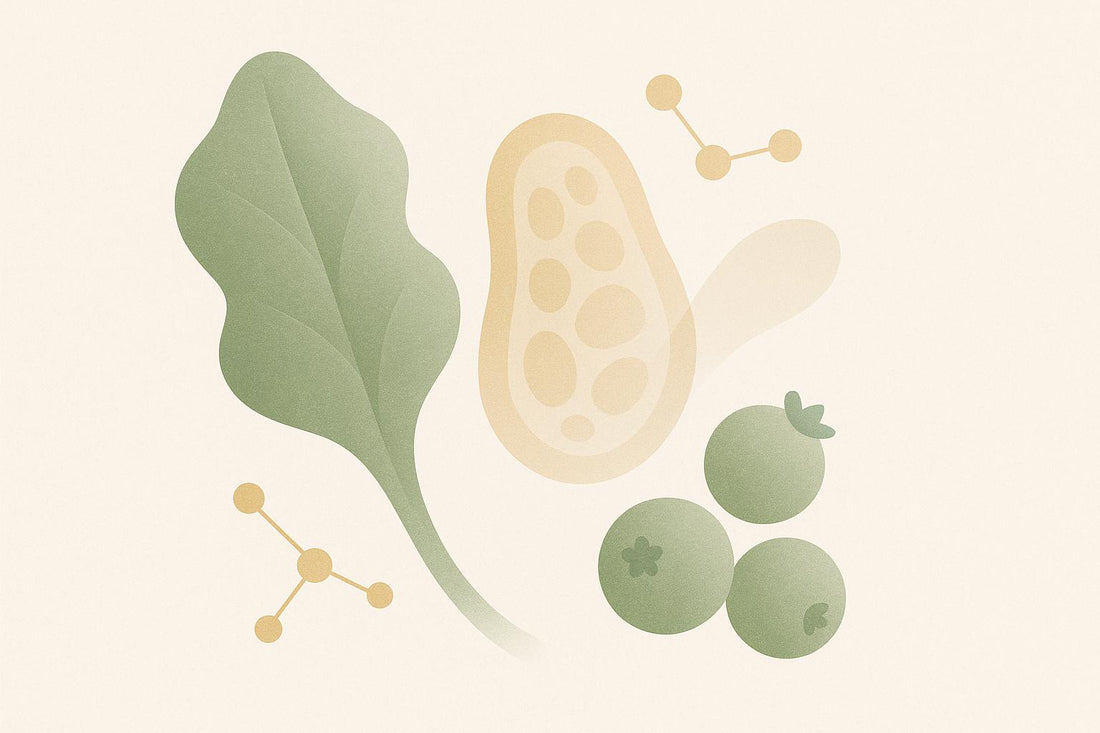An anti-inflammatory diet focuses on reducing inflammation in the body by eating whole, nutrient-rich foods while avoiding processed and inflammatory items. Chronic inflammation is linked to serious health issues like heart disease, diabetes, and cancer, but adjusting your diet can help reduce these risks and improve overall well-being.
Key Steps to Get Started:
- Eat More: Fruits, vegetables (especially leafy greens), whole grains, legumes, lean proteins, and healthy fats like olive oil and omega-3-rich fish.
- Avoid: Processed foods, refined sugars, trans fats, and excessive alcohol.
- Incorporate Anti-Inflammatory Foods: Berries, fatty fish (salmon, sardines), turmeric, ginger, garlic, nuts, seeds, and olive oil.
- Cooking Tips: Use olive oil instead of butter, bake or steam foods, and season with anti-inflammatory spices like turmeric and cinnamon.
- Meal Prep: Plan and batch-cook meals using whole foods to stay consistent.
- Balance Your Plate: Fill half with fruits and vegetables, a quarter with whole grains, and a quarter with lean protein.
Common Mistakes to Avoid:
- Relying on processed “health” foods with hidden additives.
- Eating a limited variety of foods, which can lead to nutrient gaps.
- Viewing it as a short-term fix instead of a long-term lifestyle.
How to Start An Anti-Inflammatory Diet | Ask Cleveland Clinic's Expert

Foods That Fight Inflammation
An anti-inflammatory diet thrives on variety, with each type of food contributing unique compounds to help reduce inflammation. As Dr. Frank Hu, Professor of Nutrition and Epidemiology at the Harvard School of Public Health, explains:
Many experimental studies have shown that components of foods or beverages may have anti-inflammatory effects [3].
Fruits and Vegetables
Fruits and vegetables are your go-to for battling inflammation. Packed with antioxidants and polyphenols, they help neutralize harmful substances in the body [3]. A good rule of thumb? Fill your plate with a "rainbow" of colors for maximum benefits [7].
Berries, for example, are inflammation-fighting powerhouses. Research links higher berry consumption to lower risks of heart disease, Alzheimer's, and diabetes [5]. Strawberries, blueberries, and similar fruits owe their benefits to compounds like anthocyanins and ellagic acid.
Apples and stone fruits are also impressive. A study involving nearly 35,000 women found that eating apples and pears was associated with a lower risk of heart disease-related death [5]. Meanwhile, cherries, peaches, and plums provide fiber, vitamin C, and phytochemicals that can even help reduce post-exercise soreness.
Leafy greens and cruciferous vegetables like spinach, kale, broccoli, and cauliflower are nutrient-dense and rich in flavonoids, carotenoids, and antioxidants, all of which combat inflammation [6] [8]. Carrots, for instance, contain compounds like falcarinol and falcarindiol, which help reduce inflammatory proteins [6] [8].
Tomatoes are another excellent choice, thanks to their lycopene content, which may help lower cancer-related inflammation [6]. Similarly, grapes contain resveratrol and anthocyanins, which reduce inflammation and support heart health, as well as lower the risk of diabetes and arthritis [6].
For the best results, eat seasonally. Enjoy grapes and stone fruits in summer, apples and pears in fall, persimmons and pomegranates in winter, and citrus and cherries in spring [5]. Aim for 1.5 to 2 cups of diverse fruits daily to maximize antioxidant intake [5].
Pair these plant-based choices with healthy fats to amplify their anti-inflammatory effects.
Healthy Fats and Omega-3s
Omega-3 fatty acids are essential for reducing inflammation, as your body can't produce them on its own [10]. These fats, especially EPA and DHA, work by altering cell membranes and creating anti-inflammatory compounds called resolvins [9].
Fatty fish like salmon, mackerel, herring, and sardines are excellent sources of EPA and DHA. Eating these fish twice a week can lower inflammation and reduce the risk of chronic diseases [10]. Higher doses of fish oil (over 2.6 grams daily) have been shown to reduce inflammatory markers such as C-reactive protein [10].
A 2021 review of 70 studies found that fish oil significantly reduced pain, stiffness, and disease activity in people with rheumatoid arthritis. Some participants taking higher doses were even able to reduce or stop using anti-inflammatory medications, with benefits lasting for up to eight months [10].
For those following vegetarian or vegan diets, algal oil, derived from algae, offers both DHA and EPA [10]. However, research suggests that omega-3s from foods like salmon may be more effective than supplements [10].
Olive oil is another standout. The 2021 Cordioprev trial, published in Stroke, found that a Mediterranean diet rich in olive oil and other polyphenol-rich foods slowed the progression of atherosclerosis in people with coronary heart disease [8].
Herbs, Spices, and Whole Grains
In addition to fruits and healthy fats, herbs, spices, and whole grains can also play a key role in reducing inflammation.
Herbs and spices are concentrated sources of anti-inflammatory compounds, making them an easy addition to any meal [15]. Turmeric, for instance, contains curcumin, known for its strong anti-inflammatory and antioxidant properties [13]. Pairing turmeric with black pepper enhances curcumin absorption, thanks to piperine in the pepper [11]. A 2022 study published in Free Radical Biology and Medicine found that turmeric supplements combined with piperine were especially effective in reducing oxidative stress and inflammation in hemodialysis patients [11].
Ginger and garlic are versatile options for soups, stir-fries, and marinades [13] [15]. Cinnamon and cloves can easily be added to oatmeal or baked goods [13]. A 2012 study identified spices like paprika, rosemary, sage, turmeric, ginger, and cumin as some of the most effective for reducing inflammation [14].
Whole grains are another important component of an anti-inflammatory diet. They help regulate blood sugar and reduce inflammation, making them a healthier choice over refined grains. Options like brown rice, quinoa, barley, buckwheat, and whole-wheat bread are all great picks [12]. Oats, in particular, contain beta-glucan, a soluble fiber that slows digestion and stabilizes blood sugar [12]. As Vandana Sheth, RDN, CDCES, explains:
The antioxidants and anti-inflammatory compounds found in whole grains may help reduce risk of complications related to chronic inflammation in those with diabetes [12].
Starting your day with oatmeal or quinoa can provide steady energy while actively working to reduce inflammation [12].
How to Start Your Anti-Inflammatory Diet
Starting an anti-inflammatory diet doesn’t have to feel overwhelming. The secret is to make small, gradual changes that naturally turn into lasting habits. As Liz Moore, a registered dietitian at Harvard-affiliated Beth Israel Deaconess Medical Center, puts it:
"Start by slowly making changes so that these become more of a lifestyle shift rather than 'going on a diet.'" [2]
By taking it one step at a time, you can build on the anti-inflammatory food choices mentioned earlier and set yourself up for long-term wellness. Here’s how to ease into it.
Transition to Whole Foods Step by Step
Rather than trying to overhaul your diet overnight, start by swapping out processed foods for whole, unprocessed options. For example, trade charcuterie or French fries for veggie slices with hummus or baked sweet potatoes. When it comes to dessert, opt for naturally sweet choices like dark chocolate with fruit instead of sugary bakery treats. Pay attention to food labels to avoid hidden sugars and trans fats, and stick to this simple rule: "Eat fewer foods that come from packages and more that come from the ground" [1] [2].
Adjust your cooking methods too. Choose baking, steaming, or stir-frying instead of deep frying or grilling, and use olive oil, vinegar, and herbs instead of butter- or cheese-heavy sauces. To ease into the change, try adding one anti-inflammatory food to your meals each week while gradually cutting back on foods that contribute to inflammation [7].
Focus on Balanced, Anti-Inflammatory Meals
Once you’ve started reducing processed foods, shift your attention to building meals that actively support your anti-inflammatory goals. A good rule of thumb is to center your plate around a protein - like salmon or chickpeas - and pair it with a vegetable and a whole grain [15]. This ensures you’re getting a mix of fruits, vegetables, and healthy fats, which are key to fighting inflammation.
Bring variety and color to your meals by incorporating a range of fruits and vegetables. For breakfast, try a fruit smoothie or oatmeal topped with berries. At lunch, build a salad with dark leafy greens, mixed vegetables, beans, nuts, and seeds. For dinner, combine lean protein with a colorful array of vegetables, and finish with fruit for dessert [2]. Enhance your dishes with anti-inflammatory spices like turmeric, ginger, rosemary, cinnamon, and oregano for flavor without the need for extra salt or sugar [15].
This approach mirrors eating patterns like the Mediterranean and DASH diets, which emphasize fruits, vegetables, unsaturated fats, minimally refined whole grains, and oily fish - all staples of an anti-inflammatory diet [16].
Simplify with Meal Prep and Batch Cooking
Consistency is key to maintaining an anti-inflammatory lifestyle, and meal prep can make it much easier to stay on track. Begin by stocking your kitchen with essentials like leafy greens, berries, healthy fats (such as olive oil and avocado), fatty fish, herbs, spices, whole grains, and plant-based proteins [18].
Organize your grocery list by category and prepare bulk batches of ingredients to streamline your week. For example, cook lean proteins like salmon, lentils, or organic chicken; make large portions of whole grains like quinoa or brown rice; and roast a variety of vegetables - such as sweet potatoes, broccoli, and bell peppers - with olive oil and herbs [18]. Store your prepared food in BPA-free, freezer-safe containers labeled with the prep date and contents.
To make busy days easier, pre-portion smoothie ingredients or put together themed meal kits like "Mediterranean Monday" or "Taco Tuesday." Remember, meal prep isn’t about being perfect - it’s about staying consistent. Start small and aim to cook enough to cover a few days at a time [18].
sbb-itb-4f17e23
Meal Planning Made Simple
Crafting an anti-inflammatory meal plan doesn’t have to be complicated. With a clear approach and a few smart strategies, you can create meals that fit seamlessly into your lifestyle.
Daily Meal Structure
A simple way to balance your meals is by visualizing your plate: half should be filled with fruits and vegetables, one-quarter with whole grains, and one-quarter with lean protein [20]. Add a touch of healthy fats, like a drizzle of extra-virgin olive oil or a handful of nuts, to help reduce inflammation [20]. Focus on antioxidant-rich foods such as berries, dark leafy greens, and seafood to maximize anti-inflammatory benefits [19]. Including a variety of colorful fruits and vegetables - green, blue, purple, red, orange, yellow, and white - can further enhance your meals. Don’t forget to season generously with spices and herbs for flavor and added health benefits [15].
As registered dietitian Samantha Cassetty puts it:
"An anti-inflammatory diet is often one that also improves gut health because it's full of fiber, antioxidants, and whole, plant-based foods." [20]
This straightforward approach makes it easy to prepare balanced, nutrient-packed meals every day.
Quick Meal Ideas for Every Time of Day
Even with a packed schedule, sticking to an anti-inflammatory plan is doable by focusing on whole foods, simple one-pan dishes, and quick, no-cook options like salads or wraps.
For breakfast, try oatmeal topped with berries and cinnamon or a spinach-berry smoothie blended with ground flaxseed. Lunch could be a quinoa salad loaded with mixed vegetables, chickpeas, and a homemade olive oil and lemon dressing. Dinner might feature baked salmon paired with roasted sweet potatoes and broccoli, seasoned with rosemary and olive oil. Making your own dressings and marinades using oil, vinegar, herbs, and spices helps you avoid unhealthy additives [15].
These meal ideas are not only quick but also practical, especially with a little kitchen prep ahead of time.
Stock Your Kitchen with the Right Foods
Having the right ingredients on hand makes it easier to stick to your meal plan. Keep your pantry stocked with essentials like extra-virgin olive oil for cooking and dressings [21]. Store turmeric and black pepper together to enhance curcumin absorption and boost the anti-inflammatory properties of your meals [21]. Canned tuna is a convenient source of omega-3s, while dried or canned lentils provide phytonutrients that help regulate inflammation [22].
Almonds make a great snack or salad topping, and green tea is a fantastic addition for its polyphenol content [21]. Stocking up on staples like nuts, seeds, and frozen vegetables can also save time when preparing meals.
Dr. Frank Hu from Harvard School of Public Health highlights the broader benefits of a healthy diet:
"A healthy diet is beneficial not only for reducing the risk of chronic diseases, but also for improving mood and overall quality of life." [3]
To make weeknight cooking even easier, prep ingredients in advance. Chop vegetables, cook grains, and prepare dressings ahead of time. This way, assembling meals becomes a quick and stress-free process, helping you stay consistent with your anti-inflammatory goals.
Mistakes to Avoid
Starting an anti-inflammatory diet can feel like a big task, and it’s easy to stumble into habits that might slow your progress. Being aware of common missteps ahead of time can help you stay focused and develop lasting habits that reduce inflammation.
Avoid Processed "Health" Foods
A lot of products marketed as "healthy" are actually highly processed and loaded with ingredients that can trigger inflammation. Labels like "all natural" or "trans-fat free" might sound reassuring, but they can be misleading. Many of these items still contain additives that work against your efforts to lower inflammation [25].
Dr. Walter Willett, a Professor of Epidemiology and Nutrition at the Harvard T.H. Chan School of Public Health, puts it plainly:
Ultra-processing usually means that the original foods are not recognizable, and they include additives such as preservatives, oil, sugar, salt, coloring, and flavoring. It's what we mean by junk food. [23]
The key to avoiding these pitfalls? Read ingredient lists carefully. Stick to products with short, simple ingredient lists that feature items you recognize. Avoid anything packed with artificial colorings, preservatives, sweeteners, or hydrogenated oils [23][24]. Many processed foods, even those claiming to be healthy, are surprisingly high in sugar and additives that fuel inflammation.
Dr. Edwin McDonald, a gastroenterologist and trained chef, offers this practical advice:
Avoid foods you couldn't make at home, like corn chips. You can't buy corn and go home and convert it into corn chips. There are a lot of chemicals and extra stuff that go into it. A quick way to recognize ultra-processed foods is to read the ingredients and see if you can pronounce what's in it. The stuff you can't pronounce is what can promote inflammation. [4]
Focus on whole, unprocessed foods as the cornerstone of your diet. If you do buy packaged products, look for minimally processed options with ingredients you can identify. Pair this with a variety of whole foods to get the most nutritional benefit.
Expand Your Food Choices
Sticking to the same few "safe" foods might seem easier, but it can limit your intake of essential nutrients. A restricted diet can lead to nutrient deficiencies and prevent you from benefiting from the full range of bioactive compounds that help combat inflammation [17][26].
Each anti-inflammatory food offers unique benefits, and together, they create a powerful combination. For instance, research shows that people with lower Dietary Inflammatory Index scores tend to consume more fiber, lutein, and beta-carotene - nutrients typically found in a variety of plant-based foods [27]. Relying on a narrow range of foods means you miss out on these synergistic effects.
As one study highlights:
The overall risk reduction afforded by adherence to these diets comes from a synergistic combination of protective bioactive components in high quantities within these anti-inflammatory diets. [17]
To make this practical, aim for a colorful mix of fruits, vegetables, whole grains, nuts, seeds, and legumes in your meals. Not only does this keep your meals interesting, but it also ensures you’re getting a wide range of anti-inflammatory nutrients.
Commit to Long-Term Consistency
The strategies above only work if they’re part of your daily routine. One of the biggest mistakes people make is treating anti-inflammatory eating as a temporary fix rather than a lifestyle change. Without consistency, the benefits that take time to develop won’t fully materialize.
Liz Moore, a Registered Dietitian at Harvard-affiliated Beth Israel Deaconess Medical Center, emphasizes this point:
Start by slowly making changes so that these become more of a lifestyle shift rather than 'going on a diet.' [2]
When life gets hectic, lack of planning can push you back toward processed foods and old habits. Without a clear strategy or prepared meals, it’s easy to stray from your goals.
To stay consistent, establish daily meal routines. Use meal prep techniques to ensure you always have anti-inflammatory options ready to go. Keep track of your progress - not just by how you feel, but by noting which foods and meal patterns work best for your schedule. This way, you’ll build a sustainable approach that fits into your life.
Your Next Steps
Now that you’ve got the basics of an anti-inflammatory diet down - from picking the right foods to steering clear of common mistakes - it’s time to put it all into practice. Turning this knowledge into daily habits can set you on a path toward lasting health. Here’s how to make it happen.
Key Points to Remember
At its core, an anti-inflammatory diet isn’t a rigid plan. As Julia Zumpano, RD, LD, explains:
The term 'anti-inflammatory diet' doesn't refer to a specific diet regimen but to an overall style of eating [28].
The focus? Whole, unprocessed foods. Build your meals around vibrant fruits and vegetables, healthy fats like olive oil and nuts, omega-3-rich fatty fish, and whole grains. These foods are packed with antioxidants, fiber, and nutrients that naturally combat inflammation.
On the flip side, cut back on processed items. Packaged snacks, sugary drinks, refined carbs, and processed meats often contain additives and compounds that can fuel inflammation [28].
If you’re unsure whether certain foods are causing inflammation, try an elimination diet. This involves removing potential triggers for a few weeks and reintroducing them one by one to observe your body’s reaction [28].
You might also explore dietary patterns like the Mediterranean or DASH diets. Both are known for their anti-inflammatory benefits and offer practical, balanced meal ideas [28].
Adding MASI Longevity Science Supplements

While dietary changes are the foundation, supplements can provide an extra boost. MASI Longevity Science offers high-quality supplements designed to complement your anti-inflammatory efforts.
Their formulas include NMN (1,000 mg), Resveratrol (500 mg), Spermidine (3 mg), and Fisetin (500 mg) - compounds researched by institutions like Harvard Medical School and the Mayo Clinic for their role in supporting cellular health and addressing aging at its root [29].
MASI products are crafted in Germany with pharmaceutical-grade ingredients and undergo independent testing in Switzerland to ensure purity and effectiveness. They’re vegan-friendly and free from GMOs, soy, lactose, gluten, and common allergens [29].
For those over 40, MASI recommends starting with one capsule daily if you’re in your 40s, and two capsules daily if you’re 50 or older. These dosages are tailored to support energy, brain and heart health, and cellular renewal alongside your anti-inflammatory diet [29].
Start Small and Stay Consistent
The key to success is starting small. This week, try one simple change - like adding a handful of berries to your breakfast or swapping white rice for quinoa. These small steps add up over time.
Set yourself up for success by stocking your kitchen with anti-inflammatory staples. Frozen vegetables, canned beans, nuts, seeds, and olive oil are all great to have on hand for quick, healthy meals. Don’t stress over perfection - focus on the overall pattern. If one meal isn’t ideal, just make a healthier choice next time. Consistency is what truly counts.
Liz Moore, a Registered Dietitian at Harvard-affiliated Beth Israel Deaconess Medical Center, underscores this approach:
Start by slowly making changes so that these become more of a lifestyle shift rather than 'going on a diet' [2].
Reducing inflammation through diet is a long-term commitment to your health. The rewards - like better energy, improved mood, and a lower risk of chronic illness - will come with time as you stick to these habits. By combining these strategies, you’ll be well on your way to maintaining a sustainable, anti-inflammatory lifestyle.
FAQs
How can I start an anti-inflammatory diet without feeling overwhelmed?
Transitioning to an anti-inflammatory diet doesn’t have to be overwhelming. By making small, gradual changes, you can ease into a healthier lifestyle. Start by swapping out processed foods for whole, nutrient-packed options like fresh fruits, vegetables, whole grains, nuts, seeds, and omega-3-rich fish such as salmon or mackerel. Add in healthy fats like extra virgin olive oil, and try enhancing your meals with natural spices like turmeric and ginger, known for their anti-inflammatory properties.
Make your plate more vibrant by including a variety of colorful fruits and vegetables, which not only keep meals visually appealing but also pack in essential nutrients. Instead of revamping your entire diet overnight, take it step by step. For example, you could start by replacing sugary snacks with fresh fruit or swapping refined grains for whole grains. These small, steady changes can help you create lasting habits without feeling overwhelmed.
If you’re looking for additional ways to support your health and longevity, you might want to check out MASI Longevity Science supplements. With ingredients like NMN, Resveratrol, and Spermidine, these supplements are crafted to promote cellular health and overall wellness.
How can I maintain a balanced diet while following an anti-inflammatory eating plan?
To stick to an anti-inflammatory eating plan, focus on incorporating a variety of whole, nutrient-dense foods into your meals. Fresh fruits, vegetables, whole grains, nuts, seeds, legumes, and fatty fish like salmon are excellent choices. These foods are rich in antioxidants, fiber, and healthy fats, which can help reduce inflammation. Make sure to include omega-3 fatty acids from sources like walnuts and flaxseeds, and add fermented options like yogurt or kimchi to promote a healthy gut.
Steer clear of processed foods, refined carbohydrates, and added sugars, as these can contribute to inflammation. Instead, aim for a colorful plate filled with a mix of foods to ensure you're getting a broad spectrum of nutrients that support your overall well-being. For extra nutritional support, you might explore science-based supplements, such as those offered by MASI Longevity Science, which focus on cellular health and promoting healthy aging.
What foods and supplements are best for reducing inflammation?
To help manage inflammation, start by adding anti-inflammatory foods to your meals. Some great choices include tomatoes, olive oil, leafy greens like spinach and kale, nuts such as almonds and walnuts, fatty fish like salmon and mackerel, and fruits like berries, cherries, and oranges. These foods are packed with nutrients and antioxidants that naturally help reduce inflammation.
You can also consider supplements to complement your diet. Options like omega-3 fatty acids (found in fish oil), curcumin (from turmeric), resveratrol, ginger, vitamin D, and green tea extract are known for their anti-inflammatory properties. These supplements work at the cellular level to target inflammation and can support your efforts when combined with balanced eating habits.
For high-quality, science-backed supplements, MASI Longevity Science offers products like Resveratrol and NMN, designed with a focus on purity and effectiveness.




